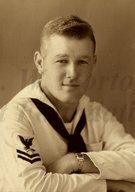
|

|
|
|
|
Woodrow was born in Norborne, Missouri, a small town about fifty miles south of Kansas City. "Woody," as he would be known, was one of five children. After the family split up when he was very young, he lived with John and Alice Dixon, an aunt and uncle. He enjoyed a boyhood of sports, playing football, basketball, and softball. He also ice-skated. To supplement the family table, he hunted rabbits, which he sold for twenty-five cents a piece. Unable to find work after graduating from Norborne High School in 1937, Woodrow enlisted in the U.S. Navy in February of 1938 and was sent to San Diego for boot camp. He was assigned to the USS Nevada (BB-36) as a signalman using semaphore flags. The sailors called them skivvies, and signalmen, "skivvy wavers." Woodrow recalls going on exercises out of California, and being aware that Japanese submarines were "out there watching us." Woodrow worked shifts of four hours, with four hours off, and earned $21 per month as an apprentice seaman. Later at a higher rank he made $52 per month. The Nevada sailed to Honolulu, "about a year before the war started," he says. On December 7, 1941, he was in his bunk and dressed and ready to go to shore, and reading the newspaper. "The headlines were that the guy from Japan was in Washington, D.C. talking to our guys, and it looked like peace was going to break out, and everything was going to be settled," he recalls. "I was reading the paper and I felt the ship shake." He remembers the boatswain's mate over the loudspeaker. "He said, `Man your battle stations on the double! This is no shit!'" he recalls. Woodrow sprinted up to the main deck just as a Japanese plane "came down and killed a bunch of guys" who were running to get to the guns. "Here come these planes coming down from this side, and we'd run to that side. And they'd come down from the other side, we'd run to that side," he recalls. One bomb killed about 19 Marines who were manning the broadside guns. He says the USS Arizona (BB-39) "blew up right in front of me." The Nevada got underway into the channel. "They hit us with a couple of torpedoes and the ship started to lean off to the left," he says. The senior officer aboard ordered the ship run aground on Hospital Point, so it wouldn't block the channel. All hands were given rifles, and remained aboard "all day and all night," he says. "Everybody on the ground was shooting at these planes coming in," he says. "And they were our own planes. We were shooting down a lot of our own planes coming in from the States." The next day, "they took all of us off the ships and put us over in a baseball field somewhere," he recalls. Woodrow was transferred to the USS Louisville (CA-28). The ship bombarded the Japanese in the Marshall Islands, where it did "quite a bit of damage," he says. "Then we went back into Pearl Harbor and that's when I saw all the damage," he recalls. When the Louisville returned to the States for dry docking, Woodrow was sent to the east coast for duty aboard troop ships bound for England. His ship also took British troops around South Africa to Port Said, where it picked up Italian prisoners and dropped them off at a prison in Cape Town, South Africa. The Louisville then returned to New York alone. "I expected to be torpedoed at any time," he recalls of the trip. In Boston he boarded a transport ferrying troops to the invasion of North Africa. His vessel was one of three sunk in the Mediterranean by torpedoes from "Germans or Italians," he says. Ordered to abandon ship, he swam to a raft, then was rescued by a British ship. Woodrow, by then a First Class Petty Officer, was sent to Gulfport, Mississippi, to train new officers on how to read semaphore, Morse code, and international flags. He was on similar temporary duty in New Orleans when he was promoted to ensign. After a year in Gulfport and New Orleans he was sent to San Francisco, from where he sailed to Okinawa on the heavy cruiser, USS New Orleans, (CA-32). It bombarded the island for "about two and a half months." After the war ended, the New Orleans served in Operation Magic Carpet, the effort to ferry troops back to the States. The ship carried "maybe two thousand troops," he recalls. "They were sleeping all over the decks. We'd turn around in San Francisco and come back and get another load." The New Orleans participated in Mardi Gras in New Orleans, then was decommissioned. On April 6, 1946 Woodrow married Beatrice Albertine. They would have three children and four grandchildren. He remained in the Navy, retiring as a lieutenant in 1958. He eventually opened an office supply business in Metairie. "I was at the beginning of the war and I was at the ending of the war at Okinawa," is how he sums up his military career. |


